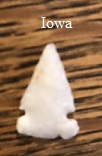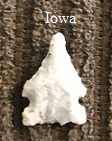Outline is Representative of Size and Shape:

Name Details:
Identified By: David A. Baerreis
Named For: Type Site
Date Identified: 1954
Type Site: Reed Site, Grand River Valley, Oklahoma
Identified By: David A. Baerreis
Named For: Type Site
Date Identified: 1954
Type Site: Reed Site, Grand River Valley, Oklahoma
Point Validity:
Valid type
Baerris is a well published anthropologist and was a professor at the University of Wisconsin-Madison. This type was named in a professional publication and has many professional references. This is considered a valid type.
Reed Side Notched
Cluster: Cahokia Cluster Description of Physical Characteristics and Flaking Pattern:
This is a thin small (typically .75 to 1 inch) triangular side notch point with an elliptical cross section. The blade is primarily excurvate, but may also be straight. Serrations are generally not present on this type. This point has parallel notches. The shoulder may range from straight to a slightly upward angle. The stem is expanding, but has a change in angle from that of the blade. The Basal edge may range from straight to slightly contracting. The base is primarily straight, but may be slightly concaved. Basal grinding is not present on this point. This point has random flaking pattern.
Size Measurements:
Total Length - 20 to 45 mm, Stem Length (to top of notch) - 8 to 13 mm, Neck Width - 5 to 8 mm, Basal Width - 10 to 15 mm
Total Length - 20 to 45 mm, Stem Length (to top of notch) - 8 to 13 mm, Neck Width - 5 to 8 mm, Basal Width - 10 to 15 mm
Commonly Utilized Material:
Additional Comments:
Bell (1958) points out that this type is similar to the Washita point. However, the stem in this point has a marked change from the angle of the blade while the Washita point continues the angle of the blade from the tip to the base. Parallel notches are commonly lower on the blade on the Reed point and higher on the blade for the Washita point.
The points in this cluster are similar to the points in the Woodland/Mississippian triangular cluster, except these points have side notches (Morrow, 1984). Both types of points are noted for being thin and in the shape of an isosceles or equilateral triangle. Points in this cluster are noted for a single or multiple parallel notches in the blade. The blade may be serrated for points in this cluster (W2).
All points in this cluster are Mississippian or Mississippian related complexes. with primary distributions in the Mississippi River Valley.
Bell (1958) points out that this type is similar to the Washita point. However, the stem in this point has a marked change from the angle of the blade while the Washita point continues the angle of the blade from the tip to the base. Parallel notches are commonly lower on the blade on the Reed point and higher on the blade for the Washita point.
The points in this cluster are similar to the points in the Woodland/Mississippian triangular cluster, except these points have side notches (Morrow, 1984). Both types of points are noted for being thin and in the shape of an isosceles or equilateral triangle. Points in this cluster are noted for a single or multiple parallel notches in the blade. The blade may be serrated for points in this cluster (W2).
All points in this cluster are Mississippian or Mississippian related complexes. with primary distributions in the Mississippi River Valley.
Distribution:
Distribution Comments:
This point is primarily from northern Texas and Arkansas into southern Minnesota. This is a common type from Iowa to Oklahoma.
This point is primarily from northern Texas and Arkansas into southern Minnesota. This is a common type from Iowa to Oklahoma.
Age / Periods:
Date: 1,500 - 500 B.P.
Cultural Period: Late Woodland to Mississippian
Glacial Period: Roman to Medieval Warm
Culture:
Date: 1,500 - 500 B.P.
Cultural Period: Late Woodland to Mississippian
Glacial Period: Roman to Medieval Warm
Culture:
Age Details:
Similar Points:
Caracara, Cahokia, Des Moines, Harrell, Haskell, Huffaker, Little Sioux, Plains, Prairie, Washita, Washita Peno
Caracara, Cahokia, Des Moines, Harrell, Haskell, Huffaker, Little Sioux, Plains, Prairie, Washita, Washita Peno













